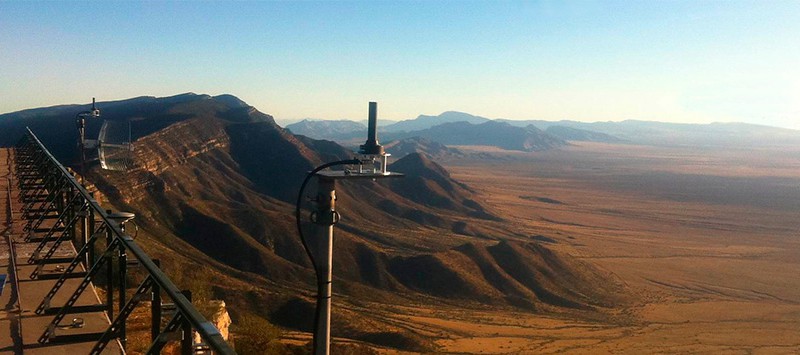Locata’s Technology Now Installed at White Sands
In December 2012, Locata was awarded a sole-source, multi-year, multi-million dollar contract by the US Air Force (USAF) to supply a large, wide area LocataNet at the White Sands Missile Range in New Mexico. In an unprecedented world-first achievement, Locata’s technology was chosen exclusively to supply the 746 Test Squadron (746 TS) based at Holloman Air Force Base, NM, with extremely accurate “reference truth” positioning across an area of up to 6,500 sq km at White Sands when GPS is being completely jammed. Locata’s technology integration partner, New Mexico-based TMC Design Corporation (TMC), was awarded a contract by the USAF to design, integrate, install and test the White Sands LocataNet. Deployment has just been completed. The LocataNet is scheduled to undergo final acceptance testing during Q4 2014. When commissioning of the LocataNet is completed, Locata’s technology will be the centerpiece of the 746 TS’ new Non-GPS Based Positioning System (NGBPS), supplying continuous centimeter-level, independent positioning without reliance on GPS. The NGBPS system enabled by Locata’s technology will give the 746 TS new, tactically significant operational capabilities, allowing the USAF to evaluate the performance of mobile and airborne positioning, navigation, and timing (PNT) equipment in GPS‐denied environments. The system consists of both fixed and mobile Command and Control (C2) nodes, and includes a network of LocataLite transceivers deployed throughout the White Sands Missile Range. When fully deployed, the NGBPS system will be capable of operating in combination with GPS, or completely independent of GPS, depending on 746 TS’ mission requirements.
Background
The 746 TS worked closely with Locata’s engineers for several years prior to the awarding of the sole-source contract for the White Sands LocataNet, during which Locata’s technology went through a detailed evaluation and testing process involving exhaustive technology demonstrations both in Australia and in the US. Final validation by the USAF occurred after a detailed technical demonstration of Locata’s high accuracy positioning technology at the White Sands Missile Range in New Mexico in October 2011. In that test, Locata established a LocataNet at White Sands that covered 3,500 sq km with just 10 LocataLite transmitters. A twin engine turboprop aircraft flown by the 746 TS flew a series of sorties in the network – day and night – over seven days recording positioning information captured by a Locata receiver on board the aircraft. The Locata receiver’s positioning data was then compared to the UASF’s state-of-the-art Truth Reference System, which was also on board the test aircraft. Post-processing of the data captured by the 746TS showed Locata was able to deliver positioning accuracy to an aircraft flying up to 25,000 ft in altitude and at speeds up to 550 mph, of 6 cm (horizontal) and 15 cm (vertical) – totally autonomous of GPS and without augmentation from any other system – terrestrial or space-based. The technical demonstration, which was a stunning validation of Locata’s capabilities, was part of the development of the USAF’s new Ultra High Accuracy Reference System (UHARS). UHARS is the 746 TS’ next generation reference system, currently under development to meet test and evaluation reference requirements for future navigation and guidance systems. UHARS will provide a highly accurate reference solution for airborne and land-based test vehicles in electronic warfare environments where modernized and legacy GPS signals are jammed from friendly or hostile systems. A detailed description of the White Sands technical demonstration can be obtained by downloading the cover story from the June 2012 edition of Inside GNSS magazine, which can be accessed via this link.

